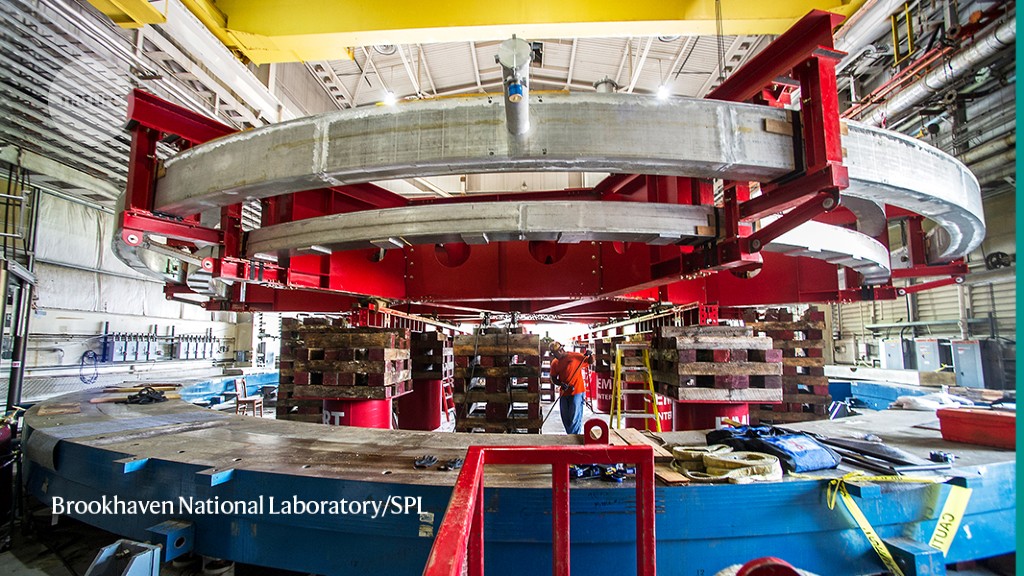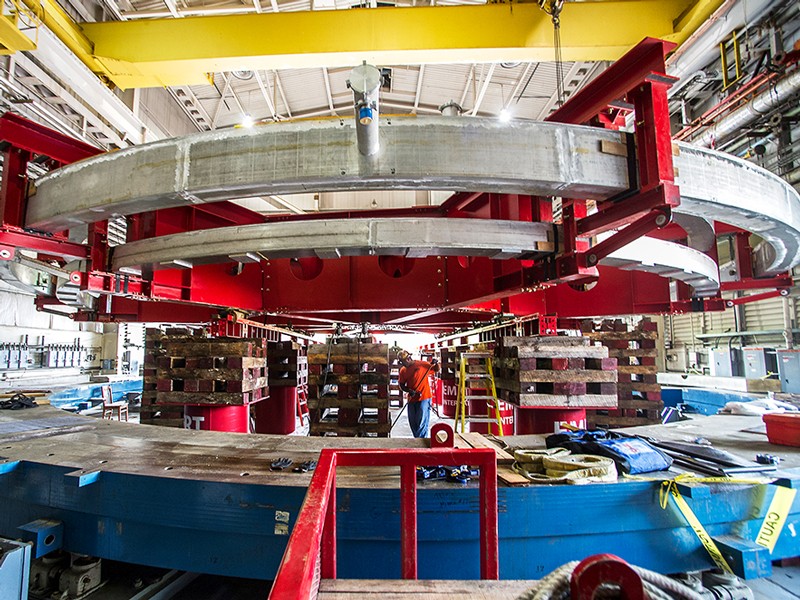The muon’s mysteries continue to leave physicists spellbound. Last year, an experiment suggested that the elementary particle had inexplicably strong magnetism, possibly breaking a decades-long streak of victories for the leading theory of particle physics, known as the standard model. Now, revised calculations by several groups suggest that the theory’s prediction of muon magnetism might not be too far away from the experimental measurements after all.
The new predictions are preliminary, and do not completely vindicate the standard model. But by narrowing the gap between theory and experiment, they might make it easier to resolve the discrepancy — while potentially creating another one.
The muon is almost identical to the electron, except that it’s 200 times heavier and short-lived, decaying millionths of a second after being created in particle collisions. Like the electron, the muon has a magnetic field that makes it act like a tiny bar magnet. As muons travel, they generate various particles that briefly pop in and out of existence. These ephemeral particles slightly increase the muon’s magnetism, known as its magnetic moment. The big question is: by how much?
If the standard model already includes all of the universe’s elementary particles, it should be able to precisely quantify this extra magnetic contribution. But if experiments prove that nature deviates from that prediction, it would point to the existence of hitherto unknown particles, whose fleeting appearances can skew the muon’s magnetic moment more than expected. Researchers have already seen hints of such a discrepancy, and have spent decades trying to improve the accuracy of both theory and experiments to confirm whether they do give different results.
Conflicting results
In 2020, the theoretical-physics community produced a consensus paper with the most accurate prediction yet for the muon’s magnetic moment1. This largely relied on calculations based on the fundamental principles of the standard model, but the researchers needed to plug in some experimental data to reflect the magnetic influence of particles such as quarks and gluons, which could not be calculated adequately using theory alone.
This calculation was soon joined by the most accurate experimental measurement of the muon’s magnetic moment. In April 2021, the Muon g – 2 experiment at the Fermi National Accelerator Laboratory (Fermilab), outside Chicago, Illinois, reported that the muon’s magnetic moment was significantly higher than the theoretical prediction2.
Yet on the very same day, physicists in a collaboration called BMW unveiled separate calculations of the magnetic moment that did not require the assistance of experimental data. They used a technique called lattice quantum chromodynamics (lattice QCD) to simulate the behaviour of quarks, gluons and other particles. This pegged the muon’s magnetic moment higher than the calculation in the 2020 consensus paper, and closer to the Muon g – 2 experimental value3.
Lattice QCD had not played a prominent part in the consensus paper because at that time the technique’s predictions were not sufficiently precise. State-of-the-art mathematical techniques and sheer supercomputing power subsequently helped the BMW team to give their lattice-QCD simulations enough of a boost to make the grade. Since then, at least eight teams of physicists around the world have been racing to validate or improve on the BMW prediction. They have started by focusing on a limited range of the particle energies that BMW simulated.
Two preliminary results from this energy ‘window’ were posted on the arXiv preprint repository in April 2022: one by Christopher Aubin at Fordham University in New York City, and his collaborators4, and the other by Gen Wang at the University of Aix-Marseille in France5. Earlier this month, two more groups — one led by Hartmut Wittig at Johannes Gutenberg University in Mainz, Germany, the other by Silvano Simula at the National Institute for Nuclear Physics in Rome — announced their own window results at a muon conference in Los Angeles, California. Simula’s group is writing a preprint, and Wittig’s group submitted its preprint on 14 June6. All four calculations validated BMW’s own window results, even though their lattice techniques vary. “Very different ways of approaching the problem are getting a very similar result,” says Aubin.
New consensus
“As time goes by, the different groups are converging on a result that agrees with BMW’s, at least in the intermediate window,” says Davide Giusti, a physicist at the University of Regensburg, Germany, who is a former member of Simula’s collaboration, and who now works with another lattice-QCD group led by his Regensburg colleague Christoph Lehner.
But the calculations are still preliminary, and could end up diverging once they are applied beyond the current window. “We don’t yet know if lattice results from other collaborations agree with the BMW result for the other pieces” of the calculation, says Aida El-Khadra, a theorist at the University of Illinois at Urbana-Champaign, who is part of another lattice-QCD effort.
Moreover, the Muon g – 2 experimental result is still higher than the value calculated by lattice QCD, so it’s too soon to conclude that the standard model was correct all along. The Fermilab experiment expects to publish an updated value for the magnetic moment next year, but “even if the gap between theoretical prediction and experiment turns out to be smaller — even if it’s only half as much — it would still be a large discrepancy”, Wittig says.
And if lattice QCD and experiments do end up converging on the same value, physicists would still need to explain why the 2020 consensus paper was so off the mark, says Sven Heinemeyer, a theoretical physicist at CERN, the European particle physics laboratory outside Geneva, Switzerland.
For now, physicists are left scratching their heads. “It would be hard to believe that all of our lattice simulations were wrong,” says Aubin. But it’s also hard to imagine how the data-driven calculations from 2020 could have gone awry, he says.
Still, it’s already clear that lattice QCD will have a significant impact on the muon magnetism question, says Giusti. “This calculation is truly exciting, and whatever the answer is, it will be decisive.”






More News
Measurement of the superfluid fraction of a supersolid by Josephson effect – Nature
Fusion of deterministically generated photonic graph states – Nature
How I fled bombed Aleppo to continue my career in science